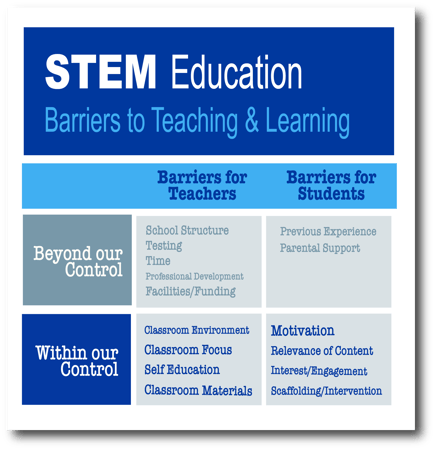
5 Easy Math Engagement Strategies for the Classroom
The news headlines are daunting. Math scores are down. School districts are scrambling to turn things around. And...
ALI Research Staff | Published January 10, 2023
Incorporating new instructional strategies into your teaching practices is always challenging at first, but it gets easier with time. If you’ve tried to integrate STEM into your classroom, you’ve probably encountered barriers, but here are some ways to find a path forward to success.

There are many ways to implement STEM education. You might have a dedicated STEM classroom; you might teach one of the four disciplines of STEM (Science, Technology, Engineering, or Mathematics) and are trying to integrate the others; maybe you teach another subject, such as language arts or social studies, and want to integrate the concepts and skills of STEM.
No matter your context or motivation, you’ve joined a community of educators bringing about an exciting revolution in learning!
If you haven’t yet, you’ll soon notice a couple of things. The first is that good STEM teaching is, at its heart, just good teaching. The best strategies to use in a STEM classroom are the best strategies for any classroom.
The second thing you’ll notice is that a few obstacles present challenges to the full and effective integration of STEM. Although not all of these obstacles are easily overcome, there are ways to address many of them and find a path forward to success.
One way to think about barriers to STEM education is in terms of two different classifications. The first classification to look at is things we can do something about and things that are out of our direct control. The second classification is the distinction between barriers to teachers trying to teach STEM, and barriers to students trying to learn STEM.

Let’s begin by acknowledging that there are barriers to STEM education that are real, significant, and beyond our direct control. For example, among the six key aspects identified in one study (Dong, Wang, & Yang et al, 2020) were lack of time, school organization and structure, and the impact of exams. To this list, another study (Ejiwale, 2013) added lack of support for the school system and poor conditions of laboratory facilities. As citizens, voters, and STEM advocates we might be able to have an impact on funding or the use of assessments, but teachers can’t do much about realities like the amount of time we have.
Now let’s focus on the barriers to teachers, challenges that make it difficult to fully and effectively implement STEM in their classrooms. A common concern, seen in both of the studies mentioned above, is lack of teacher training. This lack refers not only to situations in which those assigned to teach subjects such as science or math have taken few college credits in these areas, but also to a lack of professional development in how specifically on STEM concepts and pedagogy. Teachers usually can’t control PD, but they can take classes in STEM subjects and avail themselves of online learning resources designed specifically for STEM teachers. You might even consider getting STEM certified.
 Another major obstacle for teachers of STEM is the need for resources. First and foremost is the need to find curricular resources that include not only all four STEM disciplines but are also designed in such a way to make integration simple and seamless. Teachers looking for the best STEM curriculum resources should include in their criteria a resource that not only provides the best materials for students but also supports their own learning, what researchers call educative curriculum resources (Davis, Palincsar, Smith, Arias, & Kademian, 2017; Schneider, & Krajcik, 2002) such as STEMscopes science and math curriculum.
Another major obstacle for teachers of STEM is the need for resources. First and foremost is the need to find curricular resources that include not only all four STEM disciplines but are also designed in such a way to make integration simple and seamless. Teachers looking for the best STEM curriculum resources should include in their criteria a resource that not only provides the best materials for students but also supports their own learning, what researchers call educative curriculum resources (Davis, Palincsar, Smith, Arias, & Kademian, 2017; Schneider, & Krajcik, 2002) such as STEMscopes science and math curriculum.
In addition to curriculum resources, a STEM classroom relies heavily on physical materials– tools, technology, and, well, stuff. Many teachers already spend a lot of their own money on classroom materials, and a STEM classroom can be an even greater burden. Luckily, there are a number of grants available to teachers specifically for STEM classrooms. You can find one such list on the Snomish STEM website.
Teachers aren’t the only ones who face barriers in STEM education. Students also struggle with STEM learning. Particularly, students between the ages of 12 and 13, research (Lindahl, 2003) says, lose interest in topics related to STEM, a matter not just of failing to see the relevance of the content but also beginning to lose confidence in their own abilities in these domains.
Centering an integrated STEM program around relevant and real-world problems is essential to effective STEM teaching and learning and an effective way to address the common student complaint that school work has nothing to do with “real life”. Among the other obstacles noted by the research are a lack of inspiration on the part of students and lack of hands-on training. Here, teachers can definitely have an impact, by choosing curriculum resources and activities that inspire students (real-world problem-solving, interactive multi-media) and that have opportunities to do hands-on work with the phenomenon under investigation.
Teaching is hard and has gotten significantly harder over the past couple of years. This is not news to anyone in the classroom. Teachers who have remained in the job deserve kudos. Extra kudos, perhaps, are merited for any teacher taking on the extra effort of trying something new, especially STEM integration. Fortunately, for those who are taking on the challenge, there is a support community ready to offer guidance and support. Additionally, the rewards are worth the struggle for those who can meet the challenge. The key is to find and connect with the STEM education community, to collect and share resources, and to keep your eye on the ultimate prize, engaged and motivated students who become creative problem-solvers and lifelong learners.
References
Davis, E. A., Palincsar, A. S., Smith, P. S., Arias, A. M., & Kademian, S. M. (2017). Educative curriculum materials: Uptake, impact, and implications for research and design. Educational Researcher, 46(6), 293-304.
Dong, Y., Wang, J., Yang, Y. et al. Understanding intrinsic challenges to STEM instructional practices for Chinese teachers based on their beliefs and knowledge base. IJ STEM Ed 7, 47 (2020). https://doi.org/10.1186/s40594-020-00245-0
Ejiwale, J. (2013). Barriers to successful implementation of STEM education. Journal of Education and Learning. Vol.7 (2) 63–74.
Lindahl, B. (2003). Pupils’ responses to school science and technology? A longitudinal study of pathways to upper secondary school. Göteborg Studies in Educational Sciences, pp. 196, 1–18.
Schneider, R. M., & Krajcik, J. (2002). Supporting science teacher learning: The role of educative curriculum materials. Journal of science teacher education, 13(3), 221-245.

The news headlines are daunting. Math scores are down. School districts are scrambling to turn things around. And...

Math assessment in California is changing. What used to be a compliance exercise or reporting tool is now becoming a...

You know the moment: a student’s eyes light up when the science experiment fizzes or the math puzzle helps them...